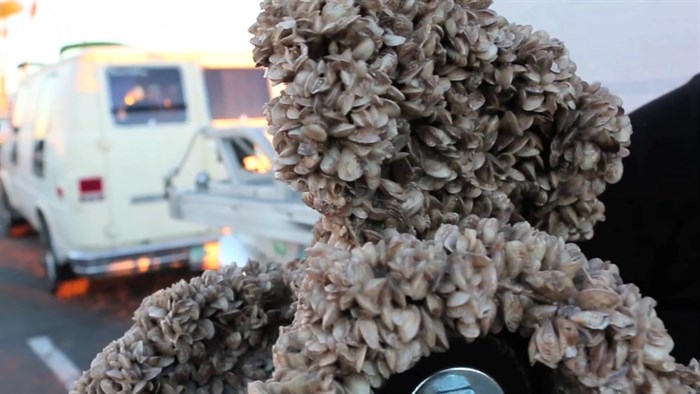
Once Zebra and quagga mussels get into a waterway, there is no known way of getting them out, Morrice says.
Image Credit: Mussel Threat
April 16, 2015 - 7:32 PM
VERNON - There may not be any zebra or quagga mussels in B.C. yet, but the threat is very real, and very urgent, says a Vernon man who spent months interviewing experts and visiting infested lakes and rivers in the U.S.
All it would take is one contaminated boat getting across the border to destroy our lakes and rivers, Brynne Morrice says.
“We can’t let that happen,” he says.
His short, six minute film Mussel Threat was shot around the Okanagan, Kootenays and Arizona — a state on the front lines of the mussel fight — and includes interviews with biologists, watercraft inspectors and community members.
Born and raised in Vernon, Morrice now lives in New York but returns to B.C. often. His interest in the threat of zebra and quagga mussels was sparked after noticing a Don’t Move a Mussel billboard, part of a campaign launched by the Okanagan Basin Water Board.
“I was at the lake swimming and thinking about it – about the risk to our lakes and beaches. It got to the point where I was literally losing sleep over it, thinking about how we’re gambling with the future of B.C. every day if we don’t do something,” he says.
He soon launched a Kickstarter campaign, and hit his goal within three days. Support continued to grow, and in a month, Morrice had $5,000 to make his film.
“I certainly learned I’m not the only one who cares deeply about B.C. and our lakes and rivers. That really strikes a chord with a lot of people. Many people are fiercely protective, and I’m glad that’s the case,” Morrice says.
One memory that stands out for him over the course of the project was seeing mussels for the first time in Arizona. The encrusted lakes were a far cry from the pristine Okanagan waters he grew up swimming in.
“They coated everything in a thick layer. It was pretty shocking, and hard not to imagine it happening in a place like Okanagan or Kalamalka Lake. I really didn’t want to think about it, but it was hard not to,” he says. “It could happen tomorrow. It would just take one boat. We’re risking it all very day.”
There is no known way of getting rid of the mussels once a waterway is infested, so preventing their arrival is the best protection, Morrice says.
But the fact is, B.C. is not very well guarded. Last year, the mussels almost made it across the border into Osoyoos. In March, the provincial government announced $1.3 million in funding to help stop mussels from coming into B.C., a commitment which includes three roving inspection stations to check boats coming into the province, but Morrice says it’s not enough.
“It’s like putting up a fence with holes in it. It needs to be an unbroken wall of defence. All it takes is one infested boat to destroy our waters,” he says. “Obviously there’s more than three border crossings in B.C. They won’t be stopping every boat.”
One of the most emotional interviews Morrice did for the film was in Christina Lake, a community that invited him to come after learning of his campaign.
“People were brought to tears talking about their lake,” Morrice says. “It’s that important to them. Their entire economy is based on the lake in the summer. Without it, they would turn into a ghost town.”
Both quagga and zebra mussels multiply rapidly. They are sharp, and eventually render beaches and lakes un-walkable. They feed on tiny phytoplankton with incredible efficiency, leaving many other creatures on the food chain, including sport fish, to starve. They can encrust boat motors, water intakes and hydroelectric dams, incurring millions of dollars in ongoing costs, Morrice says. And if that doesn’t sound bad enough, their feces fill the water and promote the growth of a harmful algae called Microcystis, a liver toxin that is dangerous to swimmers, pets and wildlife.
“Some people might wave this away because they think we’re being alarmists,” Morrice says. “But we’re being realists. This is what has happened in other places.”
He hopes people will take the time to watch the documentary — kept short so people don’t gloss over it.
“This was not about making an award winning film,” Morrice says. “This was about people understanding this, getting the scope of it, and then picking up the phone and making a call or email to an official and creating a groundswell of public pressure.”
Morrice has a degree in acting and continues to be involved in filmmaking and photography.
For more information about the mussels, and how to help, visit Protect Our Watershed.
To contact the reporter for this story, email Charlotte Helston at chelston@infonews.ca or call 250-309-5230. To contact the editor, email mjones@infonews.ca or call 250-718-2724.
News from © iNFOnews, 2015